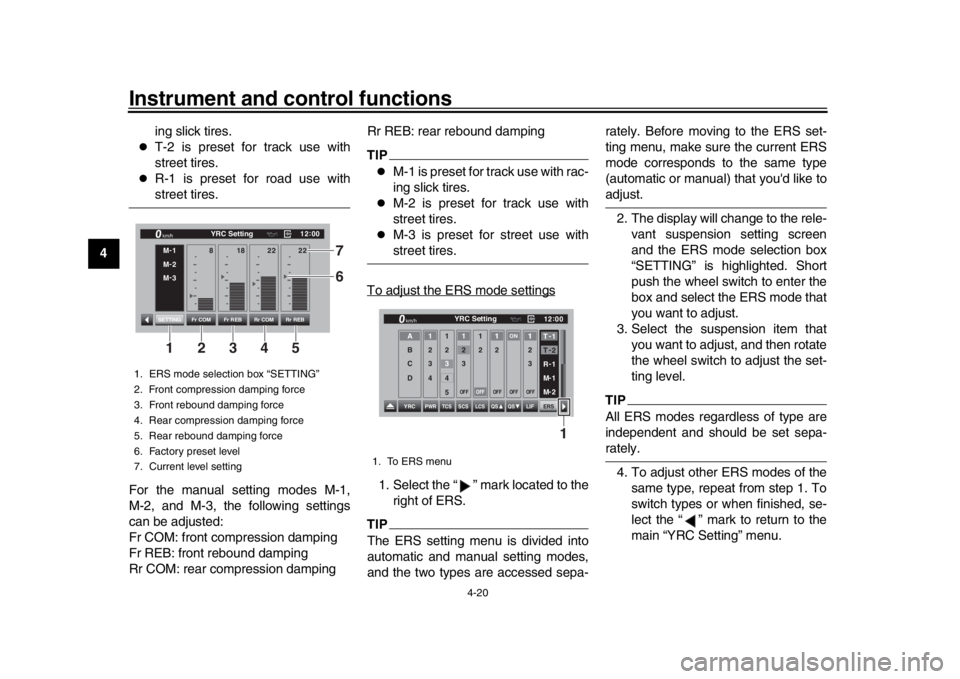tires YAMAHA YZF-R1 2018 Owners Manual
[x] Cancel search | Manufacturer: YAMAHA, Model Year: 2018, Model line: YZF-R1, Model: YAMAHA YZF-R1 2018Pages: 130, PDF Size: 10.29 MB
Page 8 of 130

Table of contentsSafety information........................... 1-1
Description ....................................... 2-1
Left view ......................................... 2-1
Right view ....................................... 2-2
Controls and instruments................ 2-3
Special features ............................... 3-1
YRC (Yamaha Ride Control) .......... 3-1
Glossary ......................................... 3-4
YRC functions visual guide............. 3-5
Instrument and co ntrol functions... 4-1
Immobilizer system ..... .................... 4-1
Main switch/steering lock................ 4-2
Handlebar switches ........................ 4-3
Indicator lights and warning lights ............................................ 4-6
Display ............................................ 4-8
MENU screen ............................... 4-14
Clutch lever................................... 4-31
Shift pedal..... ............................ .... 4-31
Brake lever ................................... 4-32
Brake pedal .................................. 4-32
Brake system ..... ....................... .... 4-33
Fuel tank cap ................................ 4-34
Fuel............................................... 4-35
Fuel tank overflow hose................ 4-37
Catalytic converter ........................ 4-37
Seats ............................................ 4-38
CCU (for equipped models) .......... 4-39 Document storage ........................ 4-40
Rear view mirrors ......................... 4-41
Adjusting the front fork ................. 4-41
Adjusting the shock absorber
assembly................................... 4-44
EXUP system ............................... 4-47
Auxiliary DC connector................. 4-48
Sidestand ..................................... 4-48
Ignition circuit cut- off system ........ 4-49
For your safety – pre-operation
checks .............................................. 5-1
Operation and important riding
points ................................................ 6-1
Starting the engine ......................... 6-1
Shifting ........................................... 6-2
Tips for reducing fuel consumption ............................... 6-3
Engine break-in .............................. 6-3
Parking ........................................... 6-4
Periodic maintenance and
adjustment ....................................... 7-1
Tool kit............................................ 7-2
Periodic maintenance charts .......... 7-3
Periodic maintenance chart for the emission control system ............. 7-3
General maintenance and lubrication chart .......................... 7-4 Removing and installing cowlings
and panels .................................. 7-8
Checking the spark plugs ............ 7-11
Canister ....................................... 7-12
Engine oil and oil filt er cartridge... 7-12
Coolant ........................................ 7-15
Air filter element ........................... 7-17
Checking the engine idling speed............ ............................ 7-17
Checking the throttle grip free play ........................................... 7-17
Valve clearance ........................... 7-18
Tires ............................................. 7-18
Cast magnesium wheels.............. 7-20
Adjusting the clutch lever free play ........................................... 7-21
Checking the brake lever free
play ........................................... 7-22
Brake light switches ..................... 7-23
Checking the front and rear
brake pads................................ 7-23
Checking the brake fluid level ...... 7-24
Changing the brake fluid .............. 7-25
Drive chain slack.......................... 7-25
Cleaning and lubricating the
drive chain ................................ 7-26
Checking and lubricating the cables ....................................... 7-27
Checking and lubricating the throttle grip and cable ............... 7-27BX4-9-E1_1.book 1 ページ 2018年4月27日 金曜日 午後4時3分
Page 12 of 130

Safety information
1-3
1
2
3
4
5
6
7
8
9
10
11
12 MENT.
Do not run engine indoors. Even if
you try to ventilate engine exhaust
with fans or open windows and
doors, carbon monoxide can rap-
idly reach dangerous levels.
Do not run engine in poorly venti-
lated or partially enclosed areas
such as barns, garages, or car-
ports.
Do not run engine outdoors where
engine exhaust can be drawn into
a building through openings such
as windows and doors.
Loading
Adding accessories or cargo to your
motorcycle can adversely affect stabili-
ty and handling if the weight distribution
of the motorcycle is changed. To avoid
the possibility of an accident, use ex-
treme caution when adding cargo or
accessories to your motorcycle. Use
extra care when riding a motorcycle
that has added cargo or accessories.
Here, along with the information about
accessories below, are some general
guidelines to follow if loading cargo to
your motorcycle: The total weight of the operator, pas-
senger, accessories and cargo must
not exceed the maximum load limit.
Operation of an overloaded vehicle
could cause an accident.
When loading within this weight limit,
keep the following in mind:
Cargo and accessory weight
should be kept as low and close to
the motorcycle as possible. Se-
curely pack your heaviest items as
close to the center of the vehicle as
possible and make sure to distrib-
ute the weight as evenly as possi-
ble on both sides of the motorcycle
to minimize imbalance or instabili-
ty.
Shifting weights can create a sud-
den imbalance. Make sure that ac-
cessories and cargo are securely
attached to the motorcycle before
riding. Check accessory mounts
and cargo restraints frequently.
Properly adjust the suspension
for your load (suspension-ad- justable models only), and
check the condition and pres-
sure of your tires.
Never attach any large or heavy items to the handlebar, front
fork, or front fender. These
items, including such cargo as
sleeping bags, duffel bags, or
tents, can create unstable han-
dling or a slow steering re-
sponse.
This vehicle is not designed to
pull a trailer or to be attached to
a sidecar.
Genuine Yamaha Accessories
Choosing accessories for your vehicle
is an important decision. Genuine
Yamaha accessories, which are avail-
able only from a Yamaha dealer, have
been designed, tested, and approved
by Yamaha for use on your vehicle.
Many companies with no connection to
Yamaha manufacture parts and acces-
sories or offer other modifications for
Yamaha vehicles. Yamaha is not in a
position to test the products that these
aftermarket companies produce.
Therefore, Yamaha can neither en-
Maximum load: 187 kg (412 lb)
BX4-9-E1_1.book 3 ページ 2018年4月27日 金曜日 午後4時3分
Page 13 of 130

Safety information
1-4
12
3
4
5
6
7
8
9
10
11
12
dorse nor recommend the use of ac-
cessories not sold by Yamaha or
modifications not specifically recom-
mended by Yamaha, even if sold and
installed by a Yamaha dealer.
Aftermarket Parts, Accessories,
and Modifications
While you may find aftermarket prod-
ucts similar in design and quality to
genuine Yamaha accessories, recog-
nize that some aftermarket accessories
or modifications are not suitable be-
cause of potential safety hazards to you
or others. Installing aftermarket prod-
ucts or having other modifications per-
formed to your vehicle that change any
of the vehicle’s design or operation
characteristics can put you and others
at greater risk of serious injury or death.
You are responsible for injuries related
to changes in the vehicle.
Keep the following guidelines in mind,
as well as those provided under “Load-
ing” when mounting accessories.
Never install accessories or carry
cargo that would impair the perfor-
mance of your motorcycle. Care-
fully inspect the accessory before using it to make sure that it does
not in any way reduce ground
clearance or cornering clearance,
limit suspension travel, steering
travel or control operation, or ob-
scure lights or reflectors.
Accessories fitted to the handle-
bar or the front fork area can
create instability due to improper
weight distribution or aerody-
namic changes. If accessories
are added to the handlebar or
front fork area, they must be as
lightweight as possible and
should be kept to a minimum.
Bulky or large accessories may seriously affect the stability of
the motorcycle due to aerody-
namic effects. Wind may at-
tempt to lift the motorcycle, or
the motorcycle may become un-
stable in cross winds. These ac-
cessories may also cause
instability when passing or being
passed by large vehicles.
Certain accessories can dis- place the operator from his or
her normal riding position. This
improper position limits the free- dom of movement of the opera-
tor and may limit control ability,
therefore, such accessories are
not recommended.
Use caution when adding electri-
cal accessories. If electrical acces-
sories exceed the capacity of the
motorcycle’s electrical system, an
electric failure could result, which
could cause a dangerous loss of
lights or engine power.
Aftermarket Tires and Rims
The tires and rims that came with your
motorcycle were designed to match the
performance capabilities and to provide
the best combination of handling, brak-
ing, and comfort. Other tires, rims, siz-
es, and combinations may not be
appropriate. See page 7-18 for tire
specifications and for information on
servicing and replacing your tires.
Transporting the Motorcycle
Be sure to observe following instruc-
tions before transporting the motorcy-
cle in another vehicle.
Remove all loose items from the
motorcycle.
BX4-9-E1_1.book 4 ページ 2018年4月27日 金曜日 午後4時3分
Page 19 of 130

Special features
3-2
1
234
5
6
7
8
9
10
11
12
cally adjusts accordin
g to the vehicle’s
lean angle. To maximize acceleration,
when the vehicle is upright a less
amount of traction control is applied.
When cornering, a greater amount of
traction control is applied.
TIP
The traction control system may
engage when the vehicle travels
over a bump.
You may notice slight changes in
engine and exhaust sounds when
the traction control or other YRC
systems engage.
When TCS is turned off, SCS,
LCS, and LIF are also turned offautomatically.
WARNING
EWA15432
The traction control system is not a
substitute for riding appropriately
for the conditions. Traction control
cannot prevent loss of traction due
to excessive speed when entering
turns, when accelerating hard at a
sharp lean angle, or while braking,
and cannot prevent front wheel slip-
ping. As with any motorcycle, ap-
proach surfaces that may be
slippery with caution and avoid es-pecially slippery surfaces.
When the key is turned to “ON”, the
traction control system automatically
turns on. The traction control system
can be turned on or off manually only
when the key is in the “ON” position and
the motorcycle is stopped.TIPTurn the traction control system off to
help free the rear wheel if the motorcy-
cle gets stuck in mud, sand, or othersoft surfaces.
NOTICE
ECA16801
Use only the specified tires. (See
page 7-18.) Using different sized
tires will prevent the traction control
system from controlling tire rotationaccurately.
SCS
The slide control system regulates en-
gine power output when a sideward
slide is detected in the rear wheel. It ad-
justs power output based on data from
the IMU. This system supports the TCS
to contribute to a smoother ride.
LCS
The launch control system helps the
rider achieve smooth and swift
launches from the starting grid. It
keeps engine speed from rising above
8,000 r/min even when the throttle
grip is fully turned. The LCS regulates
engine power output in conjunction
with the TCS and LIF systems for op-
timal traction and reduced wheel lift.
TCS
BX4-9-E1_1.book 2 ページ 2018年4月27日 金曜日 午後4時3分
Page 42 of 130

Instrument and control functions
4-20
1
2
34
5
6
7
8
9
10
11
12 ing slick tires.
T-2 is preset for track use with
street tires.
R-1 is preset for road use withstreet tires.
For the manual setting modes M-1,
M-2, and M-3, the following settings
can be adjusted:
Fr COM: front compression damping
Fr REB: front rebound damping
Rr COM: rear compression damping Rr REB: rear rebound damping
TIP
M-1 is preset for track use with rac-
ing slick tires.
M-2 is preset for track use with
street tires.
M-3 is preset for street use withstreet tires.
To adjust the ERS mode settings
1. Select the “ ” mark located to the right of ERS.TIPThe ERS setting menu is divided into
automatic and manual setting modes,
and the two types are accessed sepa- rately. Before moving to the ERS set-
ting menu, make sure the current ERS
mode corresponds to the same type
(automatic or manual) that you'd like to
adjust.
2. The display will change to the rele- vant suspension setting screen
and the ERS mode selection box
“SETTING” is highlighted. Short
push the wheel switch to enter the
box and select the ERS mode that
you want to adjust.
3. Select the suspension item that you want to adjust, and then rotate
the wheel switch to adjust the set-
ting level.TIPAll ERS modes regardless of type are
independent and should be set sepa-rately.
4. To adjust other ERS modes of the same type, repeat from step 1. To
switch types or when finished, se-
lect the “ ” mark to return to the
main “YRC Setting” menu.
1. ERS mode selection box “SETTING”
2. Front compression damping force
3. Front rebound damping force
4. Rear compression damping force
5. Rear rebound damping force
6. Factory preset level
7. Current level setting
12 :
00
YRC Setting
km/hM -
1
M -
2
M -
3
Fr COM Rr COM
Fr REB Rr REB
SETTING
18
8 22 22
134 7
5 6
2
1. To ERS menu
YRC
PWRTCS SCS LCS QS
LIF
ERS
12:
00
YRC Setting
km/h
QS
A 1
5 2 1
111 1
ON
1
OFF
1
T-
1
4 3 3 22
OFF
2OFF
3
2OFF
OFF
3
2
4
C B
D 1
T-
2
R -
1
M -
1
M -
2
1
BX4-9-E1_1.book 20 ページ 2018年4月27日 金曜日 午後4時3分
Page 74 of 130

For your safety – pre-operation checks
5-2
1
2
3
45
6
7
8
9
10
11
12
Rear brake Check operation.
If soft or spongy, have Yamaha dealer bleed hydraulic system.
Check brake pads for wear.
Replace if necessary.
Check fluid level in reservoir.
If necessary, add specified brake fluid to specified level.
Check hydraulic system for leakage. 7-23, 7-24
Clutch Check operation.
Lubricate cable if necessary.
Check lever free play.
Adjust if necessary. 7-21
Throttle grip Make sure that operation is smooth.
Check throttle grip free play.
If necessary, have Yamaha dealer adjust throttle grip free play and lubricate cable
and grip housing. 7-17, 7-27
Control cables Make sure that operation is smooth.
Lubricate if necessary. 7-27
Drive chain Check chain slack.
Adjust if necessary.
Check chain condition.
Lubricate if necessary. 7-25, 7-26
Wheels and tires Check for damage.
Check tire condition and tread depth.
Check air pressure.
Correct if necessary. 7-18, 7-20
Brake and shift pedals Make sure that operation is smooth.
Lubricate pedal pivoting points if necessary. 7-28
Brake and clutch levers Make sure that operation is smooth.
Lubricate lever pivoting points if necessary. 7-28
Sidestand Make sure that operation is smooth.
Lubricate pivot if necessary. 7-29
Chassis fasteners Make sure that all nuts, bolts
and screws are properly tightened.
Tighten if necessary. —
ITEM CHECKS PAGE
BX4-9-E1_1.book 2 ページ 2018年4月27日 金曜日 午後4時3分
Page 83 of 130

Periodic maintenance and adjustment
7-4
1
2
3
4
5
678
9
10
11
12
EAU71351
General maintenance an d lubrication chartNO. ITEM CHECK OR MAINTENANCE JOB ODOMETER READING
ANNUAL
CHECK
1000 km
(600 mi) 10000 km
(6000 mi) 20000 km
(12000 mi) 30000 km
(18000 mi) 40000 km
(24000 mi)
1 *Diagnostic system
check Perform dynamic inspection using
Yamaha diagnostic tool.
Check the error codes.
2 *Air filter element Replace. Every 40000 km (24000 mi)
3Clutch Check operation.
Adjust.
4 *Front brake Check operation, fluid level, and
for fluid leakage.
Replace brake pads if necessary.
5 *Rear brake Check operation, fluid level, and
for fluid leakage.
Replace brake pads if necessary.
6 *Brake hoses Check for cracks or damage.
Replace. Every 4 years
7 *Brake fluid Change. Every 2 years
8 *Wheels Check runout and for damage.
Replace if necessary.
9 *Tires Check tread depth and for
damage.
Replace if necessary.
Check air pressure.
Correct if necessary.
10 *Wheel bearings Check bearing for looseness or
damage.
11 *Swingarm pivot
bearings Check operation and for
excessive play.
Lubricate with lithium-soap-based grease. Every 50000 km (30000 mi)
BX4-9-E1_1.book 4 ページ 2018年4月27日 金曜日 午後4時3分
Page 97 of 130

Periodic maintenance and adjustment7-18
1
2
3
4
5
678
9
10
11
12
EAU21403
Valve clearanceThe valves are an important engine
component, and since valve clearance
changes with use, they must be
checked and adjusted at the intervals
specified in the periodic maintenance
chart. Unadjusted valves can result in
improper air-fuel mixture, engine noise,
and eventually engine damage. To pre-
vent this from occurring, have your
Yamaha dealer check and adjust the
valve clearance at regular intervals.TIPThis service must be performed whenthe engine is cold.
EAU70961
TiresTires are the only contact between the
vehicle and the road. Safety in all con-
ditions of riding depends on a relatively
small area of road contact. Therefore, it
is essential to maintain the tires in good
condition at all times and replace them
at the appropriate time with the speci-
fied tires.
Tire air pressure
The tire air pressure should be checked
and, if necessary, adjusted before each
ride.
WARNING
EWA18370
Operation of this vehicle with
improper tire air pressure may
cause severe injury or death
from loss of control.
The tire air pressure must be
checked and adjusted on cold
tires (i.e., when the temperature
of the tires equals the ambienttemperature).
WARNING
EWA10512
Never overload your vehicle. Opera-
tion of an overloaded vehicle couldcause an accident.
Tire inspection
Cold tire air pressure: Front:250 kPa (2.50 kgf/cm
2, 36 psi)
Rear:
290 kPa (2.90 kgf/cm2, 42 psi)
Maximum load*: 187 kg (412 lb)
* Total weight of rider, passenger, car- go and accessories
1. Tire sidewall
2. Tire tread depth
BX4-9-E1_1.book 18 ページ 2018年4月27日 金曜日 午後4時3分
Page 98 of 130

Periodic maintenance and adjustment
7-19
1
2
3
4
5
67
8
9
10
11
12 The tires should be checked before
each ride. If the center tread depth
reaches the specified limit, if the tire
has a nail or glass fragments in it, or if
the sidewall is cracked, have a Yamaha
dealer replace the tire immediately.
TIPThe tire tread depth limits may differ
from country to country. Always complywith the local regulations.
WARNING
EWA10472
Have a Yamaha dealer replace
excessively worn tires. Besides
being illegal, operating the vehi-
cle with excessively worn tires
decreases riding stability and
can lead to loss of control.
The replacement of all wheel
and brake-related parts, includ-
ing the tires, should be left to a
Yamaha dealer, who has the
necessary professional knowl-
edge and experience to do so.
Ride at moderate speeds after
changing a tire since the tire
surface must first be “broken
in” for it to develop its optimalcharacteristics.
Tire information
This model is equipped with tubeless
tires and tire air valves.
Tires age, even if they have not been
used or have only been used occasion-
ally. Cracking of the tread and sidewall
rubber, sometimes accompanied by
carcass deformation, is an evidence of
ageing. Old and aged tires should be checked by tire specialists to ascertain
their suitability for further use.
WARNING
EWA10482
The front and rear tires should
be of the same make and de-
sign, otherwise the handling
characteristics of the motorcy-
cle may be different, which
could lead to an accident.
Always make sure that the valve
caps are securely installed to
prevent air pressure leakage.
Use only the tire valves and
valve cores listed below to
avoid tire deflation during ahigh-speed ride.
After extensive tests, only the tires list-
ed below are approved for this model
by Yamaha.
Minimum tire tread depth (front and
rear): 1.6 mm (0.06 in)
1. Tire air valve
2. Tire air valve core
3. Tire air valve cap with seal
BX4-9-E1_1.book 19 ページ 2018年4月27日 金曜日 午後4時3分
Page 99 of 130

Periodic maintenance and adjustment7-20
1
2
3
4
5
678
9
10
11
12
WARNING
EWA10601
This motorcycle is fitted with su-
per-high-speed tires. Note the fol-
lowing points in order to make the
most efficient use of these tires.
Use only the specified replace-
ment tires. Other tires may run
the danger of bursting at super
high speeds.
Brand-new tires can have a rela-
tively poor grip on certain road surfaces until they have been
“broken in”. Therefore, it is ad-
visable before doing any
high-speed riding to ride con-
servatively for approximately
100 km (60 mi) after installing a
new tire.
The tires must be warmed up
before a high-speed run.
Always adjust the tire air pres-
sure according to the operatingconditions.
EAU66460
Cast magnesium wheelsTo maximize the performance, durabil-
ity, and safe operation of your motorcy-
cle, note the following points regarding
these wheels.
The wheel rims should be checked
for cracks, bends, warpage or
damage before each ride. If any
damage is found, have a Yamaha
dealer replace the wheel. Do not
attempt even the smallest repair to
the wheel. A deformed or cracked
wheel must be replaced.
The wheel should be balanced
whenever the tire or wheel has
been changed or replaced. An un-
balanced wheel can result in poor
performance, adverse handling
characteristics, and shortened tire
life.
These wheels are made of magnesium
and require special care.
When balancing the wheel, use
press-on type weights to avoid
scratching the wheel.
Regularly inspect the wheel for
nicks and scratches. Use touch-up
paint or other sealant to prevent
Front tire: Size: 120/70ZR17M/C (58W)
Manufacturer/model:
BRIDGESTONE/BATTLAX RAC-
ING STREET RS10F
Rear tire:
Size: 190/55ZR17M/C (75W) (YZF-R1)
200/55ZR17M/C (78W)
(YZF-R1M)
Manufacturer/model: BRIDGESTONE/BATTLAX RAC-
ING STREET RS10R
FRONT and REAR: Tire air valve:
TR412
Valve core: #9100 (original)
BX4-9-E1_1.book 20 ページ 2018年4月27日 金曜日 午後4時3分